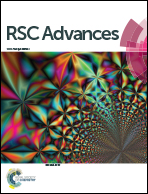Sunlight assisted degradation of dye molecules and reduction of toxic Cr(vi) in aqueous medium using magnetically recoverable Fe3O4/reduced graphene oxide nanocomposite†
Abstract
In view of the significant impact of magnetically recoverable catalysts in photocatalytic applications, Fe3O4/reduced graphene oxide (rGO) nanocomposite photocatalyst was synthesized by adopting an eco-friendly solution chemistry approach and has been characterized by high resolution transmission electron microscopy (HRTEM), X-ray photoelectron spectroscopy (XPS), Raman spectroscopy and photoluminescence (PL) spectroscopy. Fe3O4/rGO nanocomposite is efficiently utilized towards photocatalytic degradation of carcinogenic and mutagenic cationic as well as anionic dye molecules namely methyl green (MG), methyl blue (MB) and rhodamine B (RhB) under direct sunlight irradiation. The Fe3O4/rGO nanocomposite also demonstrated excellent photocatalytic reduction of aqueous Cr(VI) solution to nontoxic aqueous Cr(III) solution of more than 96% within 25 min under sunlight irradiation. Moreover, reusability of the magnetically recovered photocatalyst was studied efficiently up to 10 cycles in the degradation process. The catalyst was also characterized after the degradation of the dye molecule and the particle size of the Fe3O4 nanoparticles on the rGO sheets remained unchanged. The present investigation focuses on the importance of the use of Fe3O4/rGO nanocomposite towards photocatalytic degradation of waste water containing organic dye pollutants and toxic Cr(VI), as an easily recoverable and reusable photocatalyst with potential for many environmental remediation applications.


 Please wait while we load your content...
Please wait while we load your content...